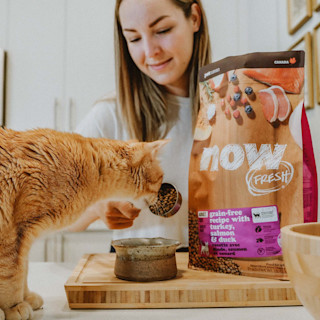January 21, 2025
First-Time Cat Owner Checklist

Are you considering getting a cat or have finally made the decision to go for it? Then you know there are some things to consider as you begin introducing a kitty to their new home. Regardless of if you’re adopting a kitten, adult, or senior cat, or even temporarily fostering, it’s important to cat-proof your home and become familiar with all the do’s and don'ts surrounding their needs.
Don’t worry though--we’ve got you covered with some first-time cat owner tips. Here is our first-time cat owner checklist to ensure you have everything you need to start your relationship off on the right paw:
Feeding Necessities
Before your new cat arrives home, you must be prepared with the essentials, with healthy cat food being the number one priority. Choose food that specifically meets the need of your cat’s age and needs. Pet specialty stores carry premium quality food tailored for kittens, adult and senior cats, as well as indoor or overweight cats.

Our Recommendation
Now Fresh Cat Food Recipes
Tailored to kittens, adult and senior cats, our premium cat food recipes provide specialized nutrition to support their health and wellbeing at every age.
View cat foodIf you’re adopting from a shelter or a breeder, it's best to give your new pet whatever food they’ve been accustomed to at the beginning, and gradually transition to a new diet if you choose to switch it up.
You can also use their daily dry food as treats for games and obedience training (yep, you can train cats!), which helps to keep them engaged and active without adding too many extra treats to their diet.
Feeding a combination of dry food and wet food is a great way to ensure your cat gets the nutrients they need with added moisture and tasty flavour.
Food and Water Bowls
It’s best to have separate bowls for food and water. Cats can be fussy, so replace the water multiple times per day to keep it fresh or try a cat water fountain if your cat prefers flowing water. If your cat doesn’t drink enough water, try adding multiple water dishes around the house to give them more options.
We recommend avoiding plastic water dishes as they’re more susceptible to bacteria growth and are harder to keep clean. Opt for stainless steel or ceramic dishes instead. Bowls should be cleaned daily and placed far away from the little box.
If you need to use an automatic feeder, choose one that can be programmed to dish out a controlled amount of food throughout the day. Free feeding with no limits can lead to unhealthy eating habits and an obese cat.
Playing (Scratchers, Toys, Engagement)
Cats have a reputation for being pretty independent, but before you bring one home make sure to plan for the mental stimulation and exercise they need to thrive. While a shoestring or an empty box might do the trick, try mixing it up with engaging toys with squeakers, feathers, or catnip to see what excites them the most.
A scratching post and cat tree are also a great idea for a new cat parent–it will give your cat a human-approved spot to scratch and naturally ‘trim’ their claws, plus provide a fun jungle gym to exercise and nap on.
Bed
Providing your new cat with a few safe, cozy napping spots around the house is a great way to help them settle into their new home. Cats often feel most secure curled up in a small, enclosed bed up high and out of the way. Try putting a covered bed on top of a shelf or cupboard they can safely access and help your new kitty decompress in a safe space. But cats being cats, don’t be discouraged if they choose the empty pizza delivery box for their bed instead.

Collar and ID Tag
The thought of losing your friendly playmate isn’t something any pet owner should have to think about. Having a way to find your cat is essential, even if your furry friend spends most of their time indoors. The best way to do this is to equip them with a collar and an ID tag. Include information such as the pets name, your name, address, and telephone number.
For those fussier felines who cannot bear to wear something around their neck, a microchip may provide an ideal way of permanent identification that will always stay with your pet. A microchip contains a unique ID number that can be read by a scanner and then matched to the owner.
Grooming
Every feline loves to groom themselves. Sometimes it's all they do with their day besides sleeping! To help them, there are some grooming practices you’ll want to adopt to keep your cat’s fur, skin, and teeth spotless.
Simple measures like weekly brushing, regular nail trimming, and occasional ear cleaning will make a significant difference in your pet’s long-term health. It can even strengthen the bond between you and your cat.
Transportation
A carrier is necessary for all cat owners! Regardless of if you think you can safely and securely hold your cat in and out of the car, it’s best to never transport them without one to keep both your cat and yourself safe.
A simple cardboard carrier or box the vet provides when bringing a new cat or kitten home is sufficient in the short term, but you'll need to replace this eventually with an enclosed carrier with secure latch and a screened opening the cat can look through. Pet stores will carry a wide variety of shapes, sizes and materials that are best suited for your cat. Ensure your cat has enough room to sit, lay down, and turn around comfortably in their new carrier.
Make sure to take the time to get your cat accustomed to the carrier before you need to use it to keep your cat’s stress levels low, especially when they're in medical distress and need to go to the vet.
Litter Box
One of the benefits of adopting cats is that they can use a litter box, rather than having to go outside. Make sure to get a litter box that is big enough for your cat, place it in a quiet place that’s free of frequent activity and invest in a non-toxic, fragrance-free clumping litter. Be sure to clean the litter every day, and if you welcome more furry friends into your home, have the same amount of litter boxes as you do pets plus one more (i.e. for two cats, have three litter boxes).

First Aid
One area of pet owners that is often overlooked is first aid kits. Keep in mind that prevention is key, but also not always possible. Be prepared with the essentials in a first aid kit, and make sure to research nearby veterinaries incase of emergencies.
Check Houseplants
It’s one of those things that is inevitable… your cat is going to want to take a nibble or knock over one of your house plants. Take this as a sign that they should be kept away for a variety of reasons. Not to mention you’ll be avoiding a mess or a damaged plant, but to further prevent serious health concerns if they were to digest parts of it.
There are on the other hand plants that are safe for pets, so be sure to ask your local greenhouse or plant expert on how to safely incorporate some budding blossoms without harming your little companion.
Catio Options
Want the best of outdoor access while keeping your cat safe at home? A catio is a patio for your cat – an outdoor cat enclosure where they can enjoy fresh air and mental stimulation while staying healthy and safely ‘inside’. Catios are not one-size-fits-all. Depending on your current living space, a catio can be any size – from just big enough for one kitty, to large outdoor cat enclosures that serve as playgrounds for multiple feline friends.
Common Mistakes
It’s one thing to impulse buy a new pair of jeans, but when it comes to animals, there’s no easy return policy if it’s just not the right fit. Be sure to do your homework when it comes to cat breeds, behaviour, and the basics of their care. Look out for these common mistakes often made by new cat owners.
Not Letting Them Adjust
Moving to a new home is stressful for anyone, especially a four-legged feline. Cats by nature are territorial and transitioning from the home or space they’re used to into a new one can cause some stress.
Some cats feel at home right away, while others can take a long time to adjust. Let them go at their own pace and don’t just plop them right into your home. Create a ‘safe room’ where they will remain until they show they are ready to start exploring the rest of the home.
Include the essentials such as a little box, bed, scratching post or pad, toys, and food dishes. Try to avoid a room that has hiding spots where they can get under large pieces of furniture, where you cannot access them, pet them, play with them, or offer treats and encouragement.
Once your cat is eating, drinking, and using the restroom normally, it is time to start the introduction process to the rest of the home. You will know they are ready, as they will begin to shower eagerness when you enter the room and curious about what is on the other side of the door. Just remember to be patient!
Switching Their Food Too Quickly
Cats are notoriously picky eaters and can be very sensitive to not just taste, but smell and texture as well. If you’re bringing home a kitten, it’s a good idea to get them used to a variety of foods early on, both to strengthen their digestive system’s resilience to new foods, and to avoid developing overly picky habits.

Adult and senior cats can be more difficult to transition to new diet, and provided they’re getting the nutrients they need and don’t develop food-related health issues, your cat can realistically eat one complete and balanced diet their entire lives. However, when switching foods becomes necessary due to aging, allergies, or other health related concerns, do not quit old food cold turkey!
Gradually introduce the new food over a 10-day period by mixing it with the old recipe, and gradually decreasing the previous food while adding in more of the new food until your cat is eating the all-new food.
Ignoring Warning Signs
Could your cat be getting sick? It is always a good idea to err on the side of caution when strange and even very subtle symptoms arise.
Cats can hide illness and pain very well so it’s important to be vigilant.
If your cat isn’t eating or drinking, or is throwing up or having diarrhea, be sure to contact your veterinarian to rule out any serious health concerns.
In Conclusion
If you're wondering what cats need in a new home, all these things are essentials and should be included on your cat proofing and need-to-know list. It may seem overwhelming at first, but in the end it’s totally worth it! With a well-prepared home, your kitty will adjust faster, and soon you'll have a purring, content best friend to pet and play with for many years to come.



